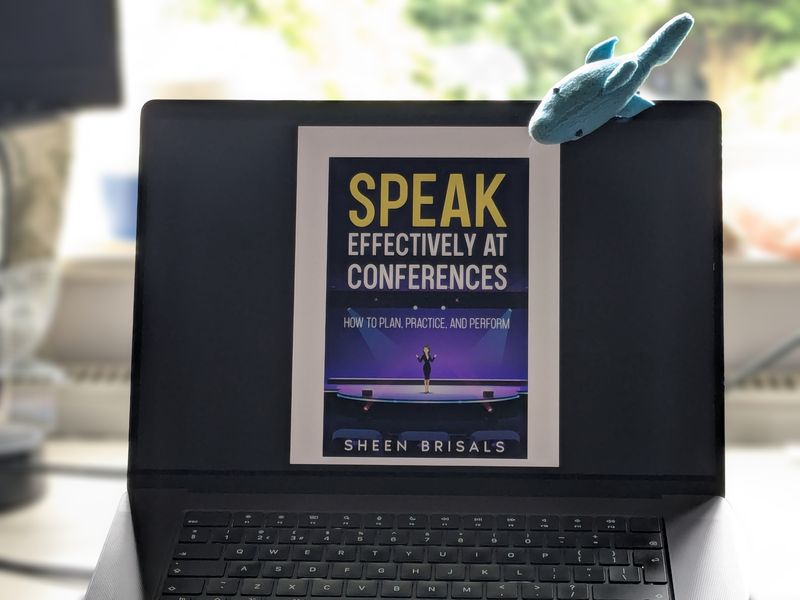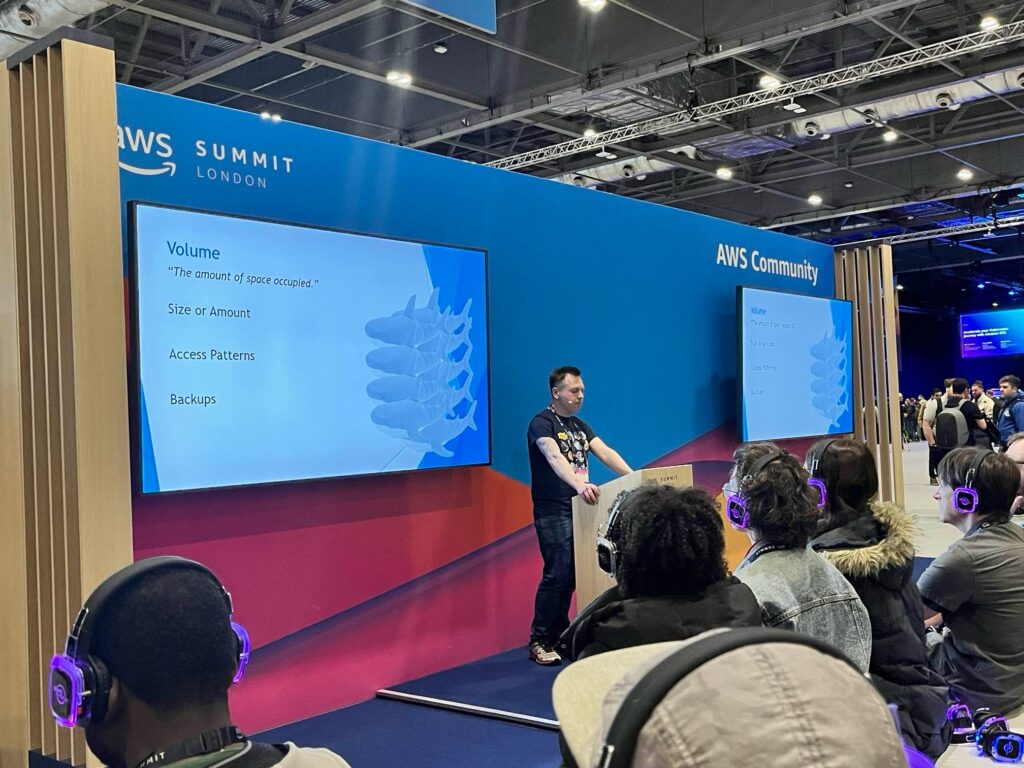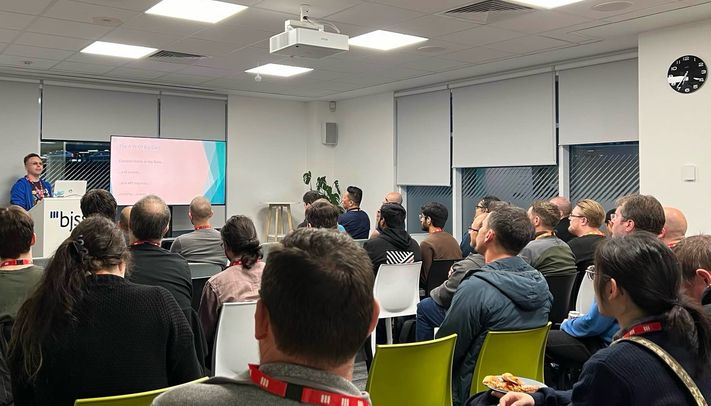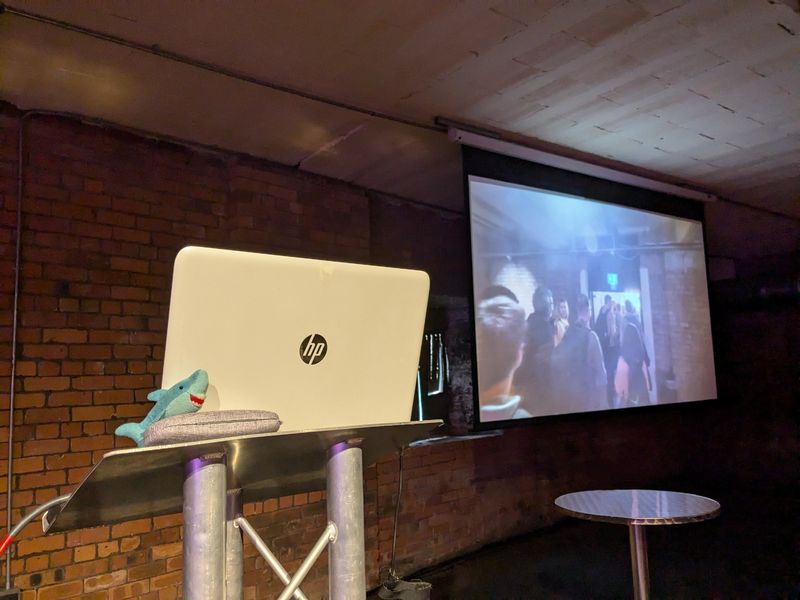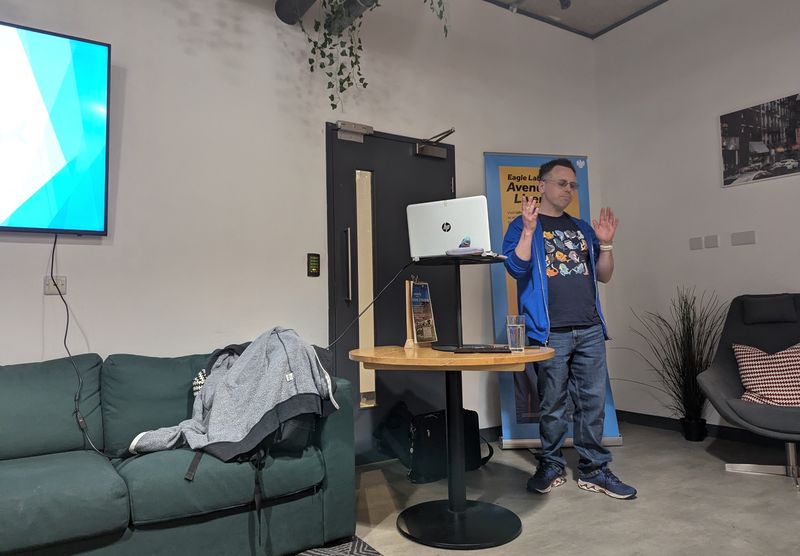In this post, I review the 2025-04 early release of Sheen Brisals’ self-published 2025 book Speak Effectively At Conferences.
Table of Contents
Introduction
This year I’ve hit double digits in my speaker profile (I know, right – how did that happen?! – Ed). And, as with my tech career, I’m always looking for ways to improve my public speaking skills.
The internet is full of advice and suggestions, but I often wonder if they’re valid and trustworthy. I also ask questions of myself. Have I picked up bad habits? Am I practising my own advice?
So when I found out about Speak Effectively At Conferences it seemed like a good investment. After reading it, I want to reflect on my expectations and the insights gained from the book. Before I dive in, let’s take a moment to learn about the author.
The Author
Sheen Brisals is an experienced engineering leader with a career beginning in the early 1990s, including roles at Oracle, Lego and, most recently, Sky. He is an international speaker, an O’Reilly author and an AWS Serverless Hero.
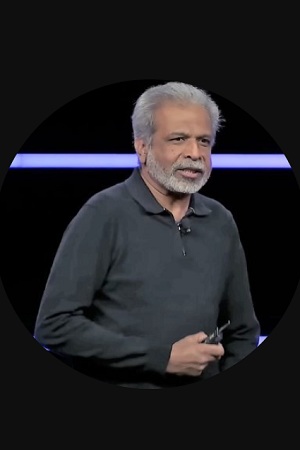
The Book
From the Speak Effectively At Conferences blurb:
Speak Effectively At Conferences…goal is to make everything about speaking at conferences known to you. It aims to familiarize you with the entire process, grow your comfort level, raise your confidence, and transform you into an effective speaker!
Speak Effectively At Conferences is published on Leanpub, a self-publishing platform where authors can release their work in stages and get feedback. It is currently available at a suggested price of $20, with discounts for students and low-income readers.
As of June 2025, Speak Effectively At Conferences is an early-release eBook. I am reviewing version 10 of the book, which was published on 11 April 2025. The book is still undergoing editing and review, and the content will be updated as this process continues. The final release will also include page numbers and an ePub version.
Motivations
This section examines my motivations for buying and reading Speak Effectively At Conferences.
Boost My Knowledge & Skills
So far, I’ve been very fortunate to have access to some great speaking-focused resources, such as:
- Online resources like the New Stars Of Data Speaker Improvement Library and Toastmasters.
- Books like Mike Acker‘s “Speak With No Fear” and Carmine Gallo‘s “Talk Like TED” and “The Presentation Secrets Of Steve Jobs“.
- Content creators like Vinh Giang and Kathy Brooke.
- Mentors like Olivier Van Steenlandt and James Eastham.
Speak Effectively At Conferences offered an opportunity to validate skills and learn from an expert. Sheen is renowned for his speaking expertise, and his book provided a great chance to explore his knowledge and insights.
Build My Confidence
Speaking of knowledge and skills, anyone reviewing my speaker profile, community involvement and career history might conclude that I am reasonably confident in using and applying them.
The reality is quite different. While I can claim to be more confident now than I was when I started this mad journey, there’s still much to work on as part of a pursuit that’s essentially endless.
As I connect with more speakers at various events, I’ve noticed that managing confidence and anxiety is a factor at all experience levels. Speakers often enjoy sharing tips with one another, so I was eager to discover what suggestions Speak Effectively At Conferences could provide. Ultimately, it could at least confirm whether others share my current habits and strategies.
Define A Roadmap
Currently, I find myself in an unexpected position as a speaker. On one hand, I can’t really call myself a new speaker anymore as my speaker events list is now in double digits. On the other hand, I don’t feel that I have enough experience to call myself an experienced speaker.
I’m seeking resources to help me advance to the next level (whatever that is). But I find myself struggling to identify what that looks like and entails. What should I measure and develop? What separates my counterproductive habits from my unique selling points?
Ultimately, I don’t know what I don’t know. Well, Sheen does! My hope with Speak Effectively At Conferences was that it would share some of his decades of experience and expertise, and might guide me towards answering some of these questions.
Book Review
In this section, I’ll summarise the various parts of Speak Effectively At Conferences and examine what stood out in each.
Part 1: Your Knowledge
Part 1 of Speak Effectively At Conferences begins before any words are spoken or slide decks are produced. It explores the historical significance of public speaking and its role in supporting basic human instincts like public gathering and group learning. Sheen examines how public speaking fosters knowledge, skills and trust for both the audience and the speaker. Additionally, the section addresses common mental barriers that new speakers may encounter.
Having built up the case for speaking, Sheen examines how to build credibility as a speaker. He explores several approaches to this, offering support and guidance on getting started. Not everyone enjoys writing or can film content, so this broad overview is a valuable addition.
Part 2: The Stage
Part 2 of Speak Effectively At Conferences focuses on the various aspects of the conference ecosystem. Sheen’s expertise is immediately apparent as he divides conferences into four (Four! – Ed) distinct groupings and examines the differences between them. These groupings all make sense – I’d just never thought about conferences in those terms before!
Sheen also explores various speaking venues, both common and uncommon. I can already tick a few off my list, including a warehouse and a cinema. However, I think I’m still a way off speaking in a ballroom!
Part 2 also examines the facilities and technology available to speakers, ranging from audio and visual equipment to private and backstage facilities. These tools vary depending on the venue – for example, don’t expect a teleprompter at a user group event. However, the right tech can make or break a session – something I can personally attest to, having been an attendee, speaker and stage manager (kinda – Ed)! I now have a persistent mistrust of HDMI cables.
Finally, Sheen comments on some of the perks of public speaking. I can imagine he gets asked about this a lot! Some of his experiences match mine – I’ve been invited to two speaker meals so far, although my nerves got the better of me for the first one! This section emphasises the themes of humility and modesty from Part 1 while considering these perks. Ultimately, public speaking isn’t about you; it’s about your audience.
Part 3: Content is King; Context is Queen
Part 3 of Speak Effectively At Conferences focuses on the lifecycle of a session, from creation to rehearsal. It begins with idea generation, curation and development. I use my Second Brain for this, and it appears that Sheen does something similar!
Then there’s a whole chapter dedicated to submitting talks, which is probably the star of the entire book for me. The Call For Paper (CFP) process has a fair amount of mystery attached to it, and rightfully so as the process should be as fair as possible. Sheen has been on both sides of the CFP process – both as applicant and reviewer – and the chapter fully reflects his wealth of experience.
Sheen also discusses how to handle CFP rejections, so don’t approach this chapter expecting hacks or a checklist for success! This is a common experience for most speakers – indeed, my Data Pipelines and Step On It sessions currently have rejection rates of 30% and 40%, respectively. So this is a thoughtful addition.
Part 3 then focuses on designing the talk itself. Sheen discusses essential elements such as the structure, flow and composition of a presentation. He then moves on to exploring slide design choices, offering creative tips and addressing common pitfalls. Part 3 ends by examining the rehearsal process. I personally have strong opinions about rehearsals that are built around another mantra of mine:
“The audience is making time for you, so make time for them.”
So seeing Sheen’s approach is very welcome. It seems we both rehearse in hotels!

It was hard to summarise this part of Speak Effectively At Conferences – there’s loads of great advice that I don’t want to spoil or misrepresent! I already see this part as the one I’ll return to most often. Most of my bookmarks led to pages here, and the advice is credible, informative and relatable.
Part 4: The Delivery
Part 4 of Speak Effectively At Conferences focuses on the act of delivering sessions. It begins by focusing on physical stance, breathing, and vocalisation, followed by exercises for mentality and concentration.
Sheen then turns his attention to preparation. This is an area with many facets, ranging from the technical and personal to the administrative. Drawing on his own experiences, Sheen offers guidance that helps readers identify what is most relevant to their current needs.
Finally, Sheen emphasises the importance of delivering a compelling session by sharing strategies for engaging the audience and improving stage presence. He offers tips for audience interaction, including how to set expectations, a framework for addressing audience questions and, equally importantly, managing off-stage interactions with the audience. This aspect often discourages many individuals from speaking, so it is reassuring to see it included.
Part 5: Life As A Speaker
Part 5 of Speak Effectively At Conferences discusses what happens after the screens go dark and the audience departs. Sheen explores themes of reflection and introspection, focusing on recognising both strengths and areas for improvement. This section also discusses feedback, highlighting what speakers can offer to the organisers and what they can receive from attendees. Learning how to give and receive feedback is an important skill, and it is an area that I need to develop.
To close, Sheen explains how he organises and shares his content. This is essential for both current projects and past materials. A well-structured and reliable warm storage system is easy to navigate, simple to access and share and effective for version control. Additionally, a legacy storage system serves as a valuable and robust knowledge repository, is easy to back up and provides guidance for the development of future content.
Thoughts
In this section, I share my thoughts on the book and how it aligns with my motivations for reading it. As the book is currently subject to change, I may revisit some of these sections in the future as needed.
Structure & Scope
The structure of Speak Effectively At Conferences is logical and well thought out, covering the entire lifecycle of a session from initial development to final retrospective. I found certain chapters particularly interesting, and they were easy to find and complemented the surrounding content. I’ve placed several bookmarks throughout the book that I’m already revisiting now, and will continue to refer to in the coming months and years.
I feel like the book’s title doesn’t do it justice. Speak Effectively At Conferences almost sells the book short, as its advice goes far beyond the conference circuit. People might see this book’s title and think it doesn’t apply to them, but Sheen’s insights are equally valid at meetups, internal presentations and many other social settings. That’s not to say every speaker will benefit from every chapter – some may not aspire to present at re:Invent; others may be content with their idea curation. However, the book’s layout and tone make it easy to find and extract the advice that fits a speaker’s specific needs.
Style & Personality
Sheen’s writing style closely reflects his personality. The book is written in a conversational and approachable manner. Many chapters incorporate Sheen’s real-world experiences, not all of which are positive. This blend of honest and credible advice, alongside an inviting tone, brought many key insights to life for me.
In fact, I found myself mentally reading several sections in his voice. If you’re reading this, Sheen, an audiobook version might be a great idea!
Takeaways & Reflections
Learning about Sheen’s speaking journey has given me valuable perspective and guidance for my own speaking goals. I found myself nodding in agreement in some parts and recognising improvement areas in others.
My main goals as a speaker have always been to improve my communication skills and build my confidence. Speak Effectively At Conferences reaffirms that speaking, like any skill, requires time, practice and a willingness to fail. Sheen’s humility and openness are evident throughout, and his willingness to share his less polished moments with his proud ones makes the book all the more impactful.
Summary
In this post, I reviewed the 2025-04 early release of Sheen Brisals’ self-published 2025 book Speak Effectively At Conferences.
Speak Effectively at Conferences is a valuable resource that offers practical advice for speakers at all levels. Sheen draws on decades of experience to provide practical guidance, whether creating a first presentation or practising a keynote speech. I plan to refer back to it often and am very pleased with my purchase.
Sheen is currently actively working on the book. The final version will be available on Amazon and other booksellers. Follow Sheen’s LinkedIn for the latest developments.
If this post has been useful then the button below has links for contact, socials, projects and sessions:
Thanks for reading ~~^~~
